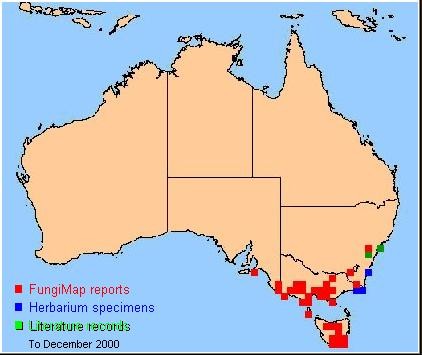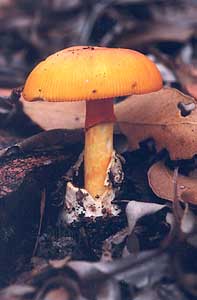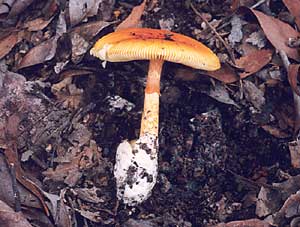The study of Australian fungi
What is the state of knowledge today?
The twentieth century saw resident mycologists studying Australian fungi and making major contributions to our knowledge, so taking steps towards fulfilling McAlpine's 1895 wish, but progress has been slow and erratic and there is still a very long way to go. It has been estimated that only about 10% of Australia's fungi have been named. There have been few professional Australian mycologists working in institutions where aging staff are replaced with younger employees. So, an amateur like Rodway would make a major contribution in Tasmania, die and have no Tasmanian continue his work. Cleland, an amateur, left no institutional legacy. In this regard it is interesting to contrast Australia with New Zealand. In the 1920s Cunningham established a herbarium and laboratory facilities, gathered some staff around him and virtually created an institution. Cunningham's legacy has endured, with that institution still in existence - even if in a different location - and employing a number of professional mycologists.
The period from about 1980 to the present has seen a healthy increase in the number of resident mycologists studying Australian fungi and the Australasian Mycological Society was formed in 1993.
Much of Cleland's 1934-35 monograph has been revised (by Cheryl Grgurinovic, currently employed as an editor with the Australian Biological Resources Study). She has added microscopic details (and drawings) to the species' descriptions and during the re-examination of Cleland's collections, described about 100 new species.
Numerous old collections of truffle-like fungi have been re-examined and many additional specimens have been collected, leading to the realisation that Australia is exceptionally rich in these species and you can find out more in the TRUFFLE SECTION. Neale Bougher and Nick Malajczuk (both at the CSIRO, Perth) and Teresa Lebel (at the Melbourne Herbarium) have been working with American "trufflologists" led by Jim Trappe, who has a world-wide perspective on the subject. This has been a very productive collaboration - both in the field and in the laboratory.
In addition there have been substantial papers on a number of agaric genera, and each time a genus has been investigated in detail the result has been the discovery of previously unknown species. Examples of people (and some of their areas of interest) are Neale Bougher (especially Cortinarius and related genera), Cheryl Grgurinovic (Mycena), Bettye Rees (Gymnopilus and some related genera), Alec Wood (Amanita, Galerina) and Tony Young (Hygrocybe and related genera). Note that the last three are producing much (or all) of that work after retirement.
| Region |
No. of species
|
| Nth America |
1320
|
| Sth America |
363
|
| Nth Europ |
463
|
| Africa |
488
|
| Asia |
343
|
| Australasia |
210
|
| WORLD |
1845
|
However, the advance in knowledge has not been even across all the fungal groups. To give just one example, consider the corticioid fungi. Here's a table showing the number of species known from various parts of the world in 1998.
Given Australia's size and the variety of habitats in the country, 210 is a
ludicrously low number of species. The most recent comprehensive study of Australasian
corticioid fungi was Cunningham's 1963 book mentioned above. ![]() Since
that time the corticioid fungi have been little studied in Australia, but subject
to much research in the northern hemisphere.
Since
that time the corticioid fungi have been little studied in Australia, but subject
to much research in the northern hemisphere.
There are still considerable gaps in geographic coverage, even in those groups
of fungi that have been better studied. The greatest attention has been paid
to the species in eastern Australia, which is not too surprising, since the
bulk of the country's population is found there (with about half of it in Sydney
and Melbourne). Of the recent people mentioned above, only Bougher and Malajczuk
were from Western Australia. Another Western Australian, Roger Hilton,
has published a list of the species found in Western Australia. He has recorded
about 500 species for which there are herbarium specimens and noted where a
particular identification may be questionable. ![]() Such
an annotated list is very valuable, for it allows other mycologists to check
the specimens on which the record for any species is based. Paradoxically, while
there's more known about the eastern Australian fungi, there is no similar annotated
checklist for any eastern state.
Such
an annotated list is very valuable, for it allows other mycologists to check
the specimens on which the record for any species is based. Paradoxically, while
there's more known about the eastern Australian fungi, there is no similar annotated
checklist for any eastern state.
In eastern Australia, the country inland from the Great Dividing Range has seen little mycological exploration. For much of the 20th century a large part of Australia was fairly inaccessible and transport relatively slow. Roads (especially sealed roads) were few and often impassable after good rains. This combination of factors also means that even when there are herbarium collections from remote areas, some groups of fungi will be under-represented. Fleshy fungi (such as mushrooms, boletes and coral fungi) produce short-lived fruiting bodies whereas fruiting bodies such as puffballs and polypores may remain for weeks or months. Thus, once the rains have passed and the ground dried enough to allow access, the fleshy fungi in the area may already have largely rotted and so yield few specimens - in contrast to the puffballs and polypores. There has also been little exploration of tropical areas (even those in eastern Australia) because access has not been easy.
For 100 species, the Fungimap project is
making use of non-mycologists to help fill in the geographic gaps. The red points
on this map show the significant contribution that Fungimap volunteers have
made to knowledge about the distribution of the species Mycena interrupta.
![]() Without the Fungimap contribution, the distribution map would be very poor.
Without the Fungimap contribution, the distribution map would be very poor.

Overseas mycologists continued to make important contributions throughout the 20th century - and will continue to do so in the future. As the bulk of the fungal genera are widespread, it's beneficial to be able to place Australian species in a world context. The American contribution to the knowledge of Australian truffle-like fungi is just one example. Mycologists at overseas herbaria have improved our knowledge by re-examining old collections, with attention now given to the microscopic detail that was missing from the original descriptions. For example, Berkeley didn't have a compound microscope until 1868 - though he'd been naming Australian collections since 1839. During the 20th century various mycologists at Kew have re-studied the 19th century Australian collections held there and revised the lists of species recorded by workers such as Berkeley and Cooke. Derek Reid, David Pegler and Brian Spooner (all on the staff at Kew at some stage) have visited Australia to collect specimens.
Roy Watling (at the Royal Botanic Gardens, Edinburgh until retirement) has had a long interest in Australian boletes and, with co-workers, has published detailed, modern studies on the Australian species. The English mycologist E.J.H. Corner included Australian coral fungi in his 1950 monograph on the group and since then the American mycologist Ronald Petersen has published additional papers on the subject. Both Watling and Petersen have collected specimens in Australia. Leif Ryvarden (Norway) and Peter Buchanan (New Zealand) have re-examined various old Australian polypore specimens and clarified a number of Australian species names. The Dutch mycologist Rudolph Maas Geesteranus recorded a good number of Australian examples in his 1971 monograph of the hydnoid fungi of Asia-Oceania. These fungi produce spores on teeth or spines, rather than on gills. Maas Geesteranus benefited greatly from specimens sent to the Netherlands by Jim Willis. This list of contributions by overseas mycologists is by no means complete, but gives some indication of the overseas involvement with Australin fungi in the 20th century.
In the century since the appearance of McAlpine's Systematic Arrangement of the Australian Fungi, the taxonomic literature about Australian fungi grew immensely - scattered through numerous books and journals. Thus, near the end of the 20th century it had again become difficult to track down relevant literature. To remedy this, the Australian Biological Resources Study (ABRS) funded the creation of an up-to-date catalogue of the relevant literature. The first volume, dealing with several groups of basidiomycetes, appeared in 1996 and was produced by by Tom May (of the Melbourne Herbarium) and Alec Wood (then at the University of NSW but now retired). The catalogue is also available online at [www.rbg.vic.gov.au/fungi/cat/] and will be expanded as additional volumes are completed. The catalogue is part of the Fungi of Australia [http://www.deh.gov.au/biodiversity/abrs/publications/fungi-of-australia/index.html] series that is being produced by ABRS as a long-term project to document the Australian macro and micro fungi.
As noted above, the bulk of the Australian fungi have not been named. Many species will not have been discovered because they are small or drab-coloured, but that's not always the case.
A recent 'new' species
Here is a striking mushroom, that has been seen a few times in northern Australia. This specimen was photographed near Rockhampton by a non-mycologist. It's clearly in the genus Amanita - but so far no species name has been given to it. It is certainly neither drab-coloured nor small. The cap is 8cm centimetres across and the stem is 8cm centimetres long. Within the genus Amanita there are a number of species with predominantly yellow to orange to red colours in both stem and cap. A well-known example in Europe is Amanita caesarea. Elsewhere in the world there are superficially similar mushrooms, so the name Amanita caesarea has been used outside Europe as well. However, careful study of both macroscopic and microscopic features has shown that the true Amanita caesarea is very likely restricted to Europe. Some of the superficially similar species from other parts of the world are: Amanita jacksonii in North America, Amanita masasiensis from Africa, Amanita caesareoides from north-east Asia and Amanita hemibapha, known from Sri Lanka and southern India.
The photographed Rockhampton specimen is clearly in the "caesarea" group, but the group is a complex one. There is still much to be done before the species in the group are well-understood. The Australian collections await the critical examination needed to determine their identities. For the moment the photographed specimen, with accompanying photographs and field notes, is a herbarium treasure awaiting study.
Previous History Pages
![An Australian Government Initiative [logo]](/images/austgovt_brown_90px.gif)



